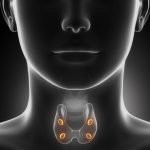Early Prostate Cancer
Overdiagnosis and radical treatment
Michael Uzick, NMD
Prostate cancer is now the second leading cause of cancer death among men in the United States. The American Cancer Society estimates over 190,000 new cases and over 27,000 deaths from prostate cancer in 2009.1 Yet, men with local disease have a 5-year survival rate of 100%. This last statistic affirms prostate cancer’s well-established tendency for slow growth and slow progression.2
With the advent of prostate specific antigen (PSA) screening, prostate cancer is detected earlier and more frequently. Since its regular use, a man’s lifetime risk for prostate cancer diagnosis has doubled (8% to 17%). Not surprisingly, 50% to 60% of newly diagnosed men have early forms of prostate cancer.3
While the benefit of early cancer detection is undoubtedly one of the most widely accepted medical axioms, in the case of prostate cancer, something is amiss. There is strong evidence that in the United States our approach to the diagnosis and treatment of early prostate cancer is needlessly causing substantial harm in many men.4
Prostate Biopsy
With the widespread use and demand for PSA screening, physicians must frequently consider the need for a biopsy referral. I have found that too many doctors are cavalier in their recommendations for prostate biopsy. There are complex reasons they may choose to do this, such as fear of a missed diagnosis, inadequate training, or even profit motives. Regardless of these and other factors, I think few would disagree that a physician must thoughtfully consider the consequences of all invasive procedures. While prostate biopsy is generally considered safe, there are several worrisome issues we should consider.
The singular form of the term “prostate biopsy” is misleading. Many doctors and most patients are unaware that the standard today is the removal of 8 to 12 core samples from this walnut-sized gland. For prostates greater than 50 mL in volume, 12 to 14 tissue samples are removed.5 When the suspicion of cancer is high, but the initial biopsy is negative, a “saturation biopsy” is commonly recommended in which =20 core tissue samples are removed from the prostate.6
The rate of several complications is rather high and not all are of minor consequence, with 6% of biopsies resulting in serious complications.
Complications of biopsy include:7
- UTI (1.2–11.3%)
- Hematuria (12.5–58.4%)
- Hematospermia (5.1–45.3%)
- Rectal bleeding (2.1–37.1%)
- Voiding difficulty (6.7–13.7%)
- Serious complications (6%)
Recently, the only study of its kind examined the mortality rate 120 days after prostate biopsy. Surprisingly, an overall mortality rate of 1.3% was found, compared to 0.3% in the older control group. Among men =81 years of age, the mortality rate was 5.5%.8 This calls into question the use of prostate biopsies in elderly men. Insight into the long-term tissue trauma following prostate biopsy was revealed in a study that followed men with magnetic resonance imaging (MRI) of the pelvis. In 49% of the men, prostatic hemorrhage persisted from 23 days to 4.5 months after the procedure.9 Given the chronic trauma observed after prostate biopsy, we should consider that the medical literature contains a plethora of studies and review articles describing chronic inflammation as a key etiological factor in the malignant transformation of prostate cells.10-12
These concerns are highlighted in a study in which 12 men each received 2 sets of prostate biopsies 7 weeks apart. All of the second samples showed two indicators of poor prognosis in prostate cancer – significantly increased expression of Ki-67 (a measure of cancer cell proliferation) and decreased staining of p27 (a tumor suppressor gene).13 In light of these findings and considering the frequency of repeat biopsies and the number of cores removed, it seems possible that some of our success in finding cancer may be a direct result of our aggressive searching for it.
Another area of concern with biopsy is the possibility of metastatic spread of cancer cells. While the risk is commonly dismissed by many doctors, a study of 667 women with breast cancer compared biopsy with lumpectomy. A 50% increase in sentinel node metastasis was found in the group subjected to biopsy.14 Further, there are numerous case reports in the medical literature describing perineal and rectal seeding of cancers after prostate biopsy.15-31 While biopsy is a crucial tool in the definitive diagnosis and treatment of prostate cancer, it is, without question, in our patients’ best interest to avoid the unnecessary use of this procedure.
How to Avoid an Unnecessary Prostate Biopsy
In patients with an elevated PSA, we can run a free PSA test to help us better determine the likelihood of cancer, thereby reducing unnecessary prostate biopsies. For example, if the free PSA is >25% there’s only a 5%-9% chance the patient has prostate cancer.32 A new test, prostate cancer gene 3 (PCA3), looks for a urinary gene marker effective in the detection of prostate cancer, but is at present only available to urologists.33
There is an online tool with perhaps better accuracy than any single test available.34 These digital nomograms are based on data collected from large studies of men undergoing prostate biopsy. By inputting non-invasive indices such as age, digital rectal exam (DRE) findings, PSA, percent free PSA, and prostate volume, this tool can predict, with up to 77% accuracy, the risk of finding cancer on biopsy.35,36 While this tool cannot differentiate between high- and low-risk cancers, it can reduce incidence of unnecessary biopsies substantially.
Radical Prostate Cancer Therapies
Conventional treatments for early prostate cancer include surgery, radiation and androgen deprivation therapy (ADT). All of these treatments have significant morbidity which may profoundly decrease a patient’s quality of life, or even lead to death. The main side effects are often permanent and include erectile dysfunction and urinary and bowel incontinence. Also, there are a myriad of often debilitating symptoms resulting from ADT (Table 1).37,38
While the conventional treatment of early prostate cancer has changed little in recent years, it is recognized that a significant number of men are unnecessarily treated with radical therapies. This current problem is described in an August 2008 report by the U.S. Preventive Services Task Force, an independent panel of experts in primary care and prevention that systematically reviews the evidence of treatment effectiveness and develops recommendations for physicians.39 The report recommends against prostate cancer screening in men 75 years and older. According to their review they “found convincing evidence that treatment for prostate cancer detected by screening causes moderate-to-substantial harms, such as erectile dysfunction, urinary incontinence, bowel dysfunction, and death. These harms are especially important because some men with prostate cancer who are treated would never have developed symptoms related to cancer during their lifetime.”39
Active Surveillance
A new approach designed specifically to reduce the over-treatment of low-risk prostate cancer is called active surveillance. It differs significantly from “watchful waiting” which loosely monitors patients and offers palliative treatment. Several clinical trials have shown encouraging results thus far.40-42 The approach is to identify “favorable-risk” patients and utilize aggressive treatment only in those at high-risk for progression based on PSA doubling time (PSADT) or increased histological stage. Favorable-risk patients are defined as those with a Gleason score =6, PSA =10 ng/ml and staged as T1c (pos. biopsy after ˜ PSA) or T2a (tumor in =50% of one lobe). For men >70 years of age the criteria include a Gleason score =7 and/or a PSA =15 ng/ml. The intervention criteria are a PSADT <3 years (usually based on at least 8 values) or grade progression to Gleason score =7 (age =70: Gleason score =8).40
Results thus far have been impressive. After following 331 men who met the criteria for active surveillance for a median of 8 years, the overall survival was 85% and the prostate cancer-specific survival was 99%.40 Of these men, 35% had been treated with radical therapies. Radical treatment occurred because of a PSADT of less than 3 years (20%), Gleason score progression (5%), and personal preference (10%).40 Thus radical treatment was used only for those at greatest risk or who chose it, while the majority of the men (65%) were spared the morbidity of radical therapies without negative consequences to their health. If we exclude the patients who were not required to, but chose to undergo radical therapies, that would mean 75% of men safely avoided debilitating and life-threatening radical treatments for about 8 years. Since active surveillance is rarely used in the United States, this research suggests that the majority of men (approx. 75%) with early prostate cancer are treated unnecessarily with radical therapies.
Another way to understand the benefit of active surveillance is to consider how many prostatectomies it would take to save one man’s life from prostate cancer. Using the data from the large 10-year Swedish and 20-year Connecticut “watchful waiting” studies, Klotz calculated the NNT (number needed to treat) for the cohort. He conservatively estimates that in a group of men with favorable-risk prostate cancer it would take 80-100 prostatectomies to save one man’s life from prostate cancer.40
Another useful tool available online is the PSADT calculator used in the Klotz active surveillance study.43 Comparing their intervention criteria (PSADT < 3-years) with a variety of other common intervention criteria, they found that other methods would have triggered recommendations for radical therapies in 10-49% of men that didn’t require such treatment. Importantly, their method for calculating PSADT is different from other methods.
In just a year’s time since I first lectured on this topic at the AANP’s annual convention, editorials and reviews in the medical literature have changed from cautious and often negative to decidedly positive. Sadly while Great Britain has incorporated active surveillance into their prostate cancer management guidelines, this is not the case in the United States.44
The principles of rational biopsy selection and active surveillance can spare our patients from potentially dangerous and debilitating invasive procedures. Active surveillance is undoubtedly a major breakthrough in solving the problem of excessive and unnecessary radical treatment of early prostate cancer. Once adopted as the standard of care, the beneficial impact on quality of life and medical costs for the roughly 100,000 men diagnosed with early prostate cancer each year will be enormous. While the potential for dramatic improvements in prostate cancer management is exciting, we as naturopathic physicians can make an even greater difference.
While this article is not about natural treatment approaches to this problem, it should be understood that there are a number of published human clinical trials demonstrating that safe natural substances like flaxseed lignans,45 vitamin D-3,46 soy isoflavones,47 lycopene,48 and pomegranate juice49 inhibit the growth of prostate cancer and significantly increase PSADT. What if, instead of simply using the principles of active surveillance, we combined them with those of naturopathic medicine? I like to think of this as “Pro-Active Surveillance.” It is reasonable to assume that such a combination would improve the benefits of active surveillance substantially.
Michael Uzick, NMD received his doctorate from Bastyr University. While in medical school he completed internships in cancer, training at Cancer Treatment Centers of America in Seattle and at the Bio-Medical (Hoxey) clinic in Tijuana. His clinical training also included specialty shifts at Bastyr’s Immune Wellness clinic. He has published articles on complementary medicine in such journals as Integrative Cancer Therapies and Alternative Medicine Review. He is a frequent lecturer on alternative therapies for cancer, hepatitis C and environmental toxicity; is a member of OncANP and the AANP; and served as the Naturopathic Medical Director for the Southern Arizona AIDS Foundation for four years. Contact: [email protected].
References
1. American Cancer Society. Cancer Facts & Figures 2009. Atlanta: American Cancer Society; 2009.
2. Wilt TJ, et al. Systematic review: comparative effectiveness and harms of treatments for clinically localized prostate cancer. Ann Intern Med. 2008;148(6):435-448.
3. Klotz L. Active surveillance for favorable risk prostate cancer: what are the results, and how safe is it? Semin Radiat Oncol. 2008;18(1):2-6.
4. Carter HB, et al. Expectant management of prostate cancer with curative intent: an update of the Johns Hopkins experience. J Urol. 2007;178(6):2359-2365.
5. Damber JE, Aus G. Prostate cancer. Lancet. 2008;371(9625):1710-1721.
6. Jones JS. Saturation biopsy for detecting and characterizing prostate cancer. BJU Int. 2007;99(6):1340-1344.
7. Djavan B, et al. Safety and morbidity of first and repeat transrectal ultrasound guided prostate needle biopsies: results of a prospective European prostate cancer detection study. J Urol. 2001;166(3):856-860.
8. Gallina A, et al. Mortality at 120 days after prostatic biopsy: a population-based study of 22,175 men. Int J Cancer. 2008;(123):647-652.
9. White S, et al. Prostate cancer: effect of postbiopsy hemorrhage on interpretation of MR images. Radiology. 1995;195(2):385-390.
10. Klein EA, Silverman R. Inflammation, infection, and prostate cancer. Curr Opin Urol. 2008;18(3):315-319.
11. Vasto S, et al. Inflammation and prostate cancer. Future Oncol. 2008;4(5):637-645.
12. Maitland NJ, Collins AT. Inflammation as the primary aetiological agent of human prostate cancer: a stem cell connection? J Cell Biochem. 2008;105(4):931-939.
13. Bergh A, et al. Transrectal core biopsy trauma may increase cell proliferation in prostate tumors. Scand J Urol Nephrol. 2002;36(4):311-313.
14. Hansen NM, et al. Manipulation of the primary breast tumor and the incidence of sentinel node metastases from invasive breast cancer. Arch Surg. 2004;139(6):634-640.
15. Vaghefi H, et al. Local recurrence of prostate cancer in rectal submucosa after transrectal needle biopsy and radical prostatectomy. Urology. 2005;66(4):881.
16. Bernhardt J, et al. Metastasis of prostate carcinoma to the lamina submucosa of the distal rectum in ulcerative colitis 2 years after transrectal prostate biopsy and radical prostatovesiculectomy. Urologe A. 2005;44(1):64-67.
17. Moul JW, et al. Perineal seeding of prostate cancer as the only evidence of clinical recurrence 14 years after needle biopsy and radical prostatectomy: molecular correlation. Urology. 1998;51(1):158-160.
18. Kassabian VS, et al. Possible mechanism for seeding of tumor during radical prostatectomy. J Urol. 1993;150(4):1169-1171.
19. Blight EM Jr. Seeding of prostate adenocarcinoma following transrectal needle biopsy. Urology. 1992;39(3):297-298.
20. Bastacky SS, et al. Needle biopsy associated tumor tracking of adenocarcinoma of the prostate. J Urol. 1991;145(5):1003-1007.
21. Ryan PG, Peeling WB. Perineal prostatic tumour seedling after Tru-Cut needle biopsy: case report and review of the literature. Eur Urol. 1990;17(2):189-192.
22. Baech J, et al.. Perineal seeding of prostatic carcinoma after Trucut biopsy. Urol Int. 1990;45(6):370-371.
23. Moul JW, et al. Risk factors for perineal seeding of prostate cancer after needle biopsy. J Urol. 1989;142(1):86-88.
24. Greenstein A, et al. Late appearance of perineal implantation of prostatic carcinoma after perineal needle biopsy. Urology. 1989;33(1):59-60.
25. Haddad FS, Somsin AA. Seeding and perineal implantation of prostatic cancer in the track of the biopsy needle: three case reports and a review of the literature. J Surg Oncol. 1987;35(3):184-191.
26. Emtage JB, Perez-Marrero R. Extension of carcinoma of prostate along perineal needle biopsy tract. Urology. 1986;27(6):548-549.
27. Brausi M, et al. Local seeding of anaplastic carcinoma of prostate after needle biopsy. Urology. 1986;27(1):63-64.
28. Addonizio JC, Kapoor SN. Perineal seeding of prostatic carcinoma after needle biopsy. Urology. 1976;8(5):513-515.
29. Puigvert A, et al. Neoplas[t]ic perineal implantation following needle biopsy (author’s translation) [in French]. Urol Int. 1975;30(4):305-312.
30. Puigvert A, et al. Perineal implantation of carcinoma of the prostate following needle biopsy: a case report. J Urol. 1972;107(5):821-824.
31. Burkholder GV, Kaufman JJ. Local implantation of carcinoma of the prostate with percutaneous needle biopsy. J Urol. 1966;95(6):801-804.
32. Catalona WJ, et al. Use of the percentage of free prostatespecific antigen to enhance differentiation of prostate cancer from benign prostatic disease: a prospective multicenter clinical trial. JAMA. 1998;279:1542–1547.
33. Kirby RS, et al. Prostate cancer diagnosis in the new millennium: strengths and weaknesses of prostate-specific antigen and the discovery and clinical evaluation of prostate cancer gene 3 (PCA3). BJU Int. 2009;103(4):441-445.
34. Cancer Prognostics and Health Outcomes Unit Web site. Take the Nomogram Challenge. http://www.nomogram.org/. 2008. Accessed October 4, 2009.
35. Karakiewicz PI, et al. Development and validation of a nomogram predicting the outcome of prostate biopsy based on patient age, digital rectal examination and serum prostate specific antigen. J Urol. 2005;173(6):1930-1934.
36. Chun FK, et al. Development and external validation of an extended 10-core biopsy nomogram. Eur Urol. 2007;52(2):436-445.
37. Bhatnagar V, et al. Estimating the risk of long-term erectile, urinary and bowel symptoms resulting from prostate cancer treatment. Prostate Cancer Prostatic Dis. 2006;9(2):136-146.
38. Gomella LG. Contemporary use of hormonal therapy in prostate cancer: managing complications and addressing quality-of-life issues. BJU Int. 2007;99(suppl 1):25-30.
39. Calonge N, et al; U.S. Preventive Services Task Force. Screening for prostate cancer: U.S. Preventive Services Task Force recommendation statement. Ann Intern Med. 2008;149(3):185-191.
40. Klotz L. Active surveillance for prostate cancer: trials and tribulations. World J Urol. 2008;26(5):437-442.
41. Khatami A, et al. PSA doubling time predicts the outcome after active surveillance in screening-detected prostate cancer: results from the European randomized study of screening for prostate cancer, Sweden section. Int J Cancer. 2007;120(1):170-174.
42. Soloway MS, et al. Active surveillance; a reasonable management alternative for patients with prostate cancer: the Miami experience. BJU Int. 2008;101(2):165-169.
43. Sunnybrook Health Sciences Centre Web site. PSA Calculator Tool. http://sunnybrook.ca/content/?page=ASURE_Calc. 2009. Accessed October 4, 2009.
44. Graham J, et al. Diagnosis and treatment of prostate cancer: summary of NICE guidance. BMJ. 2008;336(7644):610-612.
45. Demark-Wahnefried W, et al. Pilot study of dietary fat restriction and flaxseed supplementation in men with prostate cancer before surgery: exploring the effects on hormonal levels, prostate-specific antigen, and histopathologic features. Urology. 2001;58(1):47-52.
46. Woo TC, et al. Pilot study: potential role of vitamin D (Cholecalciferol) in patients with PSA relapse after definitive therapy. Nutr Cancer. 2005;51(1):32-36.
47. Pendleton JM, et al. Phase II trial of isoflavone in prostate-specific antigen recurrent prostate cancer after previous local therapy. BMC Cancer. 2008;8:132.
48. Ansari MS, Gupta NP. A comparison of lycopene and orchidectomy vs orchidectomy alone in the management of advanced prostate cancer. BJU Int. 2004;92:375-378.
49. Pantuck AJ, et al. Phase II study of pomegranate juice for men with rising prostate-specific antigen following surgery or radiation for prostate cancer. Clin Cancer Res. 2006;12(13):4018-4026.








